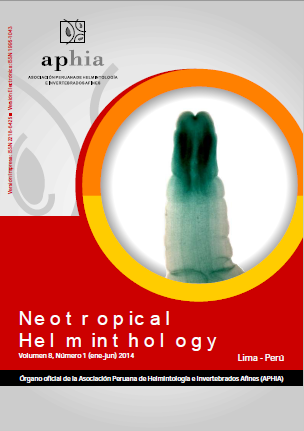PARASITOLOGICALASSESSMENT AND HOST-PARASITE RELATIONSHIP IN FARMED CACHARA CATFISH FINGERLINGS (PSEUDOPLATYSTOMA RETICULATUM EIGENMANN & EIGENMANN 1889), MATO GROSSO DO SUL, BRAZIL
DOI:
https://doi.org/10.24039/rnh201481896Keywords:
Fish parasites, histopathology, Ichthyophthirius multifiliis, Pseudoplatystoma reticulatum, Trichodina heterodentata.Abstract
Farmed fingerlings of South American catfish are frequently exposed to several parasites, but little information is available for implementing health programs for control and prevention of parasitic diseases in the hatcheries. This study evaluated the parasitic fauna of cachara catfish fingerlings (Pseudoplatystoma reticulatum Eingenmann & Eigenmann, 1889) and the hostparasite relationship during the early stages of rearing. A total of 302 cachara fingerlings were used for parasitic diagnosis and histopathological analysis. Ichthyophthirius multifiliis and Trichodina heterodentata were diagnosed as the most prevalent parasites, followed by Cryptobia sp., Henneguya sp., Monogenea and Nematoda. There was a positive correlation between the size of the fish and the mean intensity of parasitism by I. multifiliis. Proliferation of mucus cells, club cells, multifocal area of degeneration, epithelial necrosis on the body surface, skin ulceration, fusion of secondary gill lamellae and inflammatory infiltration were observed in I. multifiliisinfected fish. Ciliated protozoans were the main etiological agents diagnosed, and the cachara (P. reticulatum) is a new host for T. heterodentata. In addition, ichthyophthiriasis induced severe tissue damage thus making the fingerlings susceptible to opportunistic infections.
Downloads
Published
How to Cite
Issue
Section
License
Copyright (c) 2021 Neotropical Helminthology

This work is licensed under a Creative Commons Attribution-NonCommercial-NoDerivatives 4.0 International License.
OBJETO: El AUTOR-CEDENTE transfiere de manera TOTAL Y SIN LIMITACIÓN alguna al CESIONARIO los derechos patrimoniales que le corresponden sobre la (s) obra(s) tituladas: xxxxxxxxxxxxxxxx, por el tiempo que establezca la ley internacional. En virtud de lo anterior, se entiende que el CESIONARIO adquiere el derecho de reproducción en todas sus modalidades, incluso para inclusión audiovisual; el derecho de transformación o adaptación, comunicación pública, traducción, distribución y, en general, cualquier tipo de explotación que de las obras se pueda realizar por cualquier medio conocido o por conocer en el territorio nacional o internacional.
REMUNERACIÓN: La cesión de los derechos patrimoniales de autor que mediante este contrato se hace será a título gratuito.
CONDICIONES Y LEGITIMIDAD DE LOS DERECHOS: El AUTOR-CEDENTE garantiza que es propietario integral de los derechos de explotación de la(s) obra(s) y en consecuencia garantiza que puede contratar y transferir los derechos aquí cedidos sin ningún tipo de limitación por no tener ningún tipo de gravamen, limitación o disposición. En todo caso, responderá por cualquier reclamo que en materia de derecho de autor se pueda presentar, exonerando de cualquier responsabilidad al CESIONARIO.
LICENCIA DE ACCESO ABIERTO: El AUTOR-CEDENTE autoriza que manuscrito publicado en La Revista Neotropical Helminthology permanece disponible para su consulta pública en el sitio web https://www.neotropicalhelminthology.com/ y en los diferentes sistemas de indexación y bases de datos en las que la revista tiene visibilidad, bajo la licencia Creative Commons, en la modalidad Reconocimiento-No comercial- Sin Trabajos derivados –aprobada en Perú, y por lo tanto son de acceso abierto. De ahí que los autores dan, sin derecho a retribución económica, a la Asociación Peruana de Helmintología e Invertebrados Afines (APHIA), los derechos de autor para la edición y reproducción a través de diferentes medios de difusión.


 Numero 2 Volumen 19 - 2025 (versión Anticipada)
Numero 2 Volumen 19 - 2025 (versión Anticipada)














































